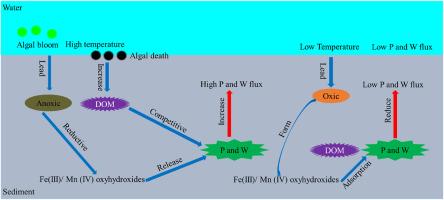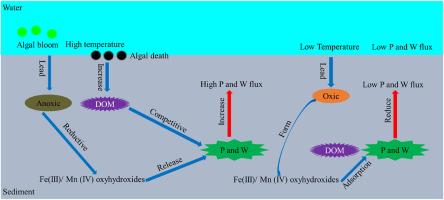季节变化促进了太湖沉积物中磷和钨通过铁/锰(氢)氧化物的还原性溶解和溶解有机物的竞争性吸附而释放
IF 7.3
2区 环境科学与生态学
Q1 ENVIRONMENTAL SCIENCES
引用次数: 0
摘要
沉积物中磷(P)和钨(W)的释放分别导致水体富营养化和重金属污染。本研究同时考察了梅梁湾沉积物中磷、W的季节变化特征。结果表明,沉积物-水界面pH、溶解氧(DO)和温度(T)的季节变化影响了沉积物中磷和W的组成及其释放。可溶性活性磷(SRP)和可溶性W(冬季除外)的扩散通量分别为0.145 ~ 2.881 mg·m−2·d - 1和1.785 ~ 3.006 μ m·2·d - 1,表明沉积物是磷和W的来源。秋季,SRP (2.881 mg·m−2·d - 1)和可溶性W (3.006 μ m−2·d - 1)的扩散通量显著高于冬季(0.147 mg·m−2·d - 1和- 0.048 μ m−2·d - 1)。冬季SRP和可溶性W浓度(分别为0.20 mg⋅L−1和0.22 μg⋅L−1)显著低于秋季(分别为1.57 mg⋅L−1和1.39 μg⋅L−1)。这些结果表明,在高温和蓝藻降解下,沉积物释放出更多的SRP、可溶性W、Fe(Ⅱ)、Mn和可溶性有机质(DOM)。SRP、可溶性W、Fe、Mn和DOM在沉积物顶部20 mm呈显著正相关,且趋势一致,说明沉积物中P、W的释放主要过程是DOM的竞争吸附和Fe (III)/Mn (IV)氢氧化物的氧化还原反应。该研究对同时解决湖泊富营养化和重金属污染具有重要的现实意义。本文章由计算机程序翻译,如有差异,请以英文原文为准。


Seasonal changes-facilitated release of phosphorus and tungsten from the Lake Taihu sediments through reductive dissolution of Fe/Mn (hydr)oxides and competitive adsorption with dissolved organic matter
The release of phosphorus (P) and tungsten (W) from sediments can contribute to eutrophication and heavy metal contamination in water bodies, respectively. This study simultaneously investigated the seasonal variation characteristics of P and W in sediments in Meiliang Bay, China. The results indicated that seasonal variations in pH, dissolved oxygen (DO), and temperature (T) at the sediment–water interface influenced the P and W composition as well as their release from sediments. The diffusion fluxes of soluble reactive phosphorus (SRP) and soluble W (except in winter) were 0.145–2.881 mg⋅m−2⋅d−1 and 1.785–3.006 μg⋅m−2⋅d−1, respectively, indicating that the sediments served as a source of P and W. In autumn, the diffusion fluxes of SRP (2.881 mg⋅m−2⋅d−1) and soluble W (3.006 μg⋅m−2⋅d−1) were significantly higher than in winter (0.147 mg⋅m−2⋅d−1 and −0.048 μg⋅m−2⋅d−1, respectively). The concentration of SRP and soluble W in winter (0.20 mg⋅L−1 and 0.22 μg⋅L−1, respectively) were significantly lower than in autumn (1.57 mg⋅L−1 and 1.39 μg⋅L−1, respectively). These results suggest that under high temperatures and cyanobacteria degradation, sediments release more SRP, soluble W, Fe(Ⅱ), Mn, and dissolved organic matter (DOM). The significant positive correlations among SRP, soluble W, Fe, Mn, and DOM and their consistent trends in the top 20 mm of the sediment indicate that the main processes causing the release of P and W from sediments are competitive adsorption by DOM and redox reactions of Fe (III)/Mn (IV) oxyhydroxides. This study is of great practical significance for simultaneously addressing lake eutrophication and heavy metal pollution.
求助全文
通过发布文献求助,成功后即可免费获取论文全文。
去求助
来源期刊

Environmental Pollution
环境科学-环境科学
CiteScore
16.00
自引率
6.70%
发文量
2082
审稿时长
2.9 months
期刊介绍:
Environmental Pollution is an international peer-reviewed journal that publishes high-quality research papers and review articles covering all aspects of environmental pollution and its impacts on ecosystems and human health.
Subject areas include, but are not limited to:
• Sources and occurrences of pollutants that are clearly defined and measured in environmental compartments, food and food-related items, and human bodies;
• Interlinks between contaminant exposure and biological, ecological, and human health effects, including those of climate change;
• Contaminants of emerging concerns (including but not limited to antibiotic resistant microorganisms or genes, microplastics/nanoplastics, electronic wastes, light, and noise) and/or their biological, ecological, or human health effects;
• Laboratory and field studies on the remediation/mitigation of environmental pollution via new techniques and with clear links to biological, ecological, or human health effects;
• Modeling of pollution processes, patterns, or trends that is of clear environmental and/or human health interest;
• New techniques that measure and examine environmental occurrences, transport, behavior, and effects of pollutants within the environment or the laboratory, provided that they can be clearly used to address problems within regional or global environmental compartments.
 求助内容:
求助内容: 应助结果提醒方式:
应助结果提醒方式:


